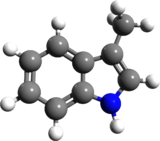스카톨(영어: skatole) 또는 3-메틸인돌(영어: 3-methylindole)은 인돌 계열에 속하는 유기 화합물이다. 고농도에서는 똥냄새가 나며, 대변의 주된 냄새 성분이다. 저농도에서는 꽃냄새가 나며, 오렌지꽃, 재스민, 인도대추(Ziziphus mauritiana)등 여러 종류의 꽃과 에센셜 오일에서 발견된다.
간략 정보 이름, 식별자 ...
스카톨
 |
 |
| 이름 |
| 우선명 (PIN)
|
| 별칭
3-methylindole
4-methyl-2,3-benzopyrrole |
| 식별자 |
|
|
|
|
| ChEBI |
|
| ChemSpider |
|
| ECHA InfoCard |
100.001.338 |
|
|
| UNII |
|
|
|
InChI=1S/C9H9N/c1-7-6-10-9-5-3-2-4-8(7)9/h2-6,10H,1H3  예 예Key: ZFRKQXVRDFCRJG-UHFFFAOYSA-N  예 예InChI=1/C9H9N/c1-7-6-10-9-5-3-2-4-8(7)9/h2-6,10H,1H3 Key: ZFRKQXVRDFCRJG-UHFFFAOYAZ
|
Cc1c[nH]c2ccccc12 c1cccc2c1c(c[nH]2)C
|
| 성질 |
|
C9H9N |
| 몰 질량 |
131.178 g·mol−1 |
| 겉보기 |
흰색 결정성 고체 |
| 냄새 |
대변 냄새 |
| 녹는점 |
93–95 °C (199–203 °F; 366–368 K) |
| 끓는점 |
265 °C (509 °F; 538 K) |
|
불용성 |
달리 명시된 경우를 제외하면, 표준상태(25 °C [77 °F], 100 kPa)에서 물질의 정보가 제공됨. |
닫기
스카톨은 많은 향수 및 방향 화합물에서 향료 및 보류제로 사용된다. "스카톨"이라는 이름은 "대변(大便 ,feces)"을 의미하는 그리스어 어원인 "skato-"에서 파생되었다. 스카톨은 1877년에 독일의 의사 루드비히 브리거(Ludwig Brieger, 1849–1919)에 의해 발견되었다.[1]
스카톨은 포유류의 소화관에서 아미노산인 트립토판으로부터 유도된다. 트립토판은 인돌아세트산으로 전환된 다음, 탈카복실화되어 메틸인돌을 생성한다.[2][3]
스카톨은 피셔 인돌 합성을 통해 합성될 수 있다.[4]
스카톨은 페로사이안화 칼륨으로 처리하면 보라색을 띈다.
스카톨은 다양한 종류의 난초꿀벌의 수컷에게 매력적인 화합물 중 하나이며, 페로몬을 합성하기 위해 화학 물질을 모으는 것으로 보인다. 스카톨은 일반적으로 연구용 꿀벌의 미끼로 사용된다.[5] 스카톨은 태즈메이니아 풀 그럽 딱정벌레(Aphodius tasmaniae)의 유인제로도 알려져 있다.[6]
스카톨은 야외 및 실험실 조건 모두에서 모기를 유인하는 역할을 하는 것으로 나타났다. 스카톨은 대변에 존재하기 때문에 하천과 호수에서 처리되지 않은 생활하수 및 산업폐수에 들어있어서 합류식 하수관거 월류수(CSO)에서 발견된다. 따라서 합류식 하수관거 월류수는 웨스트 나일 바이러스와 같은 모기 매개 질병을 연구할 때 특히 중요하다.[7]
스카톨은 염소, 양, 쥐 및 일부 마우스 균주에서 폐부종을 유발하는 것으로 나타났다. 스카톨은 폐에서 사이토크롬 P450 효소의 주요 부위인 클럽 세포를 선택적 표적으로 삼는 것으로 보인다. 이들 효소는 스카톨을 반응성 중간생성물인 3-메틸렌인돌레닌으로 전환시키고, 단백질 부가물을 형성하여 세포를 손상시킨다.[8]
정소 스테로이드인 안드로스테논과 함께 스카톨은 수퇘지의 웅취의 주요 결정요인으로 간주된다.[9]
스카톨은 구취에도 기여한다.[10]
See:
Brieger named skatole in Brieger (1877), page 1028:Original : Ich habe mich zuerst mit der Untersuchung der flüchtigen Bestandtheile der Excremente aus sauerer Lösung beschäftigt. Es wurden dabei die flüchtigen Fettsäuren: Essigsäure, normale und Isobuttersäure, sowie die aromatischen Substanzen: Phenol, Indol und eine neue dem Indol verwandte Substanz, die ich Skatol nennen werde, erhalten.
Translation : I was occupied initially with the investigation of the volitile components of excrement in acidic solution. One obtained thereby volitile fatty acids; acetic acid; normal and isobutyric acid; as well as the aromatic substances: phenol, indole and a new substance which is related to indole and which I will name "skatole".
; Brieger (1877), page 1030: Das Skatol ... (von το σχατος = faeces) ... (Skatole ... (from το σχατος = feces) ....) Yokoyama, M. T.; Carlson, J. R. (1979). “Microbial metabolites of tryptophan in the intestinal tract with special reference to skatole”. 《The American Journal of Clinical Nutrition》 32 (1): 173–178. doi:10.1093/ajcn/32.1.173. PMID 367144. Emil Fischer (1886) "Indole aus Phenylhydrazin" (Indole from phenylhydrazine), Annalen der Chemie, vol. 236, pages 126-151; for Fischer's synthesis of skatole, see page 137. (Fischer was not the first to prepare skatole. It was prepared, via other methods, in 1880 by von Baeyer, and in 1883 by Otto Fischer and German and by Fileti.) Osborne, G. O.; Penman, D. R.; Chapman, R. B. (1975). “Attraction of Aphodius tasmaniae Hope to skatole.”. 《Australian Journal of Agricultural Research》 26 (5): 839–841. doi:10.1071/AR9750839. Beechler, J W., J G Miller, and M S Mulla (1994). “Field evaluation of synthetic compounds mediating oviposition in Culex mosquitoes (Diptera: Culicidae)”. 《J Chem Ecol》 20 (2): 281–291. doi:10.1007/BF02064436. PMID 24242053. Miller, M; Kottler, S; Ramos-Vara, J; Johnson, P; Ganjam, V; Evans, T (2003). “3-Methylindole Induces Transient Olfactory Mucosal Injury in Ponies”. 《Veterinary Pathology》 40 (4): 363–70. doi:10.1354/vp.40-4-363. PMID 12824507.

